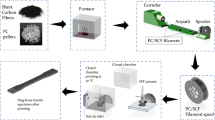Abstract
Three-dimensional (3D) printing is one of potential technologies for production of designable complex filled structures and mechanical strengthening along the reinforcing fibers for composites. The objective of this paper is to study the tensile mechanical behavior of diverse concentric fiber rings and fiber layers using glass fiber (GF), Kevlar fiber (KF), and carbon fiber (CF) printed into polymer composites and then to compare them. Additionally, it also aims to identify the influence of complex filled structures of Nylon on different fiber printed polymer composites. Tensile tests and scanning electron microscope (SEM) were utilized to characterize the 3D printed composites. Results revealed that CF-printed composite exhibits the greatest tensile strength of 110 MPa and modulus of 3941 MPa as compared to glass and Kevlar fiber composites. Increase of concentric fiber rings and fiber layers is attributed to increase in tensile strength and modulus. Also, the rectangular filled structure of Nylon declared the highest tensile strength and modulus than hexagonal and triangular filled structure owing to its rectangular filling that bears maximum load in longitudinal direction.

Continuous fiber 3D printing apparatus used to print different fibers and structures for tailoring the tensile strength and elastic modulus.







Similar content being viewed by others
References
Zhou X, Liu CJ (2017) Three-dimensional printing for catalytic applications: current status and perspectives. Adv Funct Mater 27:1701134
Sachs E, Cima M, Comie J (1990) Three-dimensional printing: rapid tooling and prototypes directly from a CAD model. CIRP Ann Manuf Technol 39:201–204
Rengier F, Mehndiratta A, von Tengg-Kobligk H, Zechmann CM, Unterhinninghofen R, Kauczor HU, Giesel FL (2010) 3D printing based on imaging data: review of medical applications. Int J Comput Assist Radiol Surg 5:335–341
Berman B (2012) 3-D printing: the new industrial revolution. Bus Horiz 55:155–162
Parandoush P, Lin D (2017) A review on additive manufacturing of polymer-fiber composites. Compos Struct 182:36–53
Sood AK, Ohdar RK, Mahapatra SS (2010) Parametric appraisal of fused deposition modelling process using the grey Taguchi method. Proc Inst Mech Eng B J Eng 224:135–145
Turner BN, Strong R, Gold SA (2014) A review of melt extrusion additive manufacturing processes: I. Process design and modeling. Rapid Prototyp J 20:192–204
Turner BN, Gold SA (2015) A review of melt extrusion additive manufacturing processes: II. Materials, dimensional accuracy, and surface roughness. Rapid Prototyp J 21:250–261
Hinchcliffe SA, Hess KM, Srubar WV (2016) Experimental and theoretical investigation of prestressed natural fiber-reinforced polylactic acid (PLA) composite materials. Compos Part B Eng 95:346–354
Hill N, Haghi M (2014) Deposition direction-dependent failure criteria for fused deposition modeling polycarbonate. Rapid Prototyp J 20:221–227
Shofner ML, Lozano K, Rodríguez-Macías FJ, Barrera EV (2003) Nanofiber-reinforced polymers prepared by fused deposition modeling. J Appl Polym Sci 89:3081–3090
Tekinalp HL, Kunc V, Velez-Garcia GM, Duty CE, Love LJ, Naskar AK, Blue CA, Ozcan S (2014) Highly oriented carbon fiber–polymer composites via additive manufacturing. Compos Sci Technol 105:144–150
Love LJ, Kunc V, Rios O, Duty CE, Elliott AM, Post BK, Smith RJ, Blue CA (2014) The importance of carbon fiber to polymer additive manufacturing. J Mater Res 29:1893–1898
Zhong W, Li F, Zhang Z, Song L, Li Z (2001) Short fiber reinforced composites for fused deposition modeling. Mater Sci Eng A 301:125–130
Ning F, Cong W, Qiu J, Wei J, Wang S (2015) Additive manufacturing of carbon fiber reinforced thermoplastic composites using fused deposition modeling. Compos Part B Eng 80:369–378
Ishii K, Todoroki A, Mizutani Y, Suzuki Y, Koga Y, Matsuzaki R, Ueda M, Hirano Y (2018) Bending fracture rule for 3D-printed curved continuous-fiber composite. Adv Compos Mater 20:1–3
Matsuzaki R, Ueda M, Namiki M, Jeong TK, Asahara H, Horiguchi K, Nakamura T, Todoroki A, Hirano Y (2016) Three-dimensional printing of continuous-fiber composites by in-nozzle impregnation. Sci Rep 6:23058
Li N, Li Y, Liu S (2016) Rapid prototyping of continuous carbon fiber reinforced polylactic acid composites by 3D printing. J Mater Process Technol 238:218–225
Tian X, Liu T, Yang C, Wang Q, Li D (2016) Interface and performance of 3D printed continuous carbon fiber reinforced PLA composites. Compos A: Appl Sci Manuf 88:198–205
Van Der Klift F, Koga Y, Todoroki A, Ueda M, Hirano Y, Matsuzaki R (2015) 3D printing of continuous carbon fibre reinforced thermo-plastic (CFRTP) tensile test specimens. Open J Compos Mater 6:18
Melenka GW, Cheung BK, Schofield JS, Dawson MR, Carey JP (2016) Evaluation and prediction of the tensile properties of continuous fiber-reinforced 3D printed structures. Compos Struct 153:866–875
Dickson AN, Barry JN, McDonnell KA, Dowling DP (2017) Fabrication of continuous carbon, glass and Kevlar fibre reinforced polymer composites using additive manufacturing. Addit Manuf 16:146–152
Acknowledgments
We would like to thank the Analytical & Testing Center of Northwestern Polytechnical University for SEM.
Funding
This work had been financially supported by Natural Science Foundation of China (51772246, 51272210, 50902112, and U1737209), Program for New Century Excellent Talents in University (NCET-13-0474), Fundamental Research Funds for the Central Universities (3102017jg02001 and 3102018jcc002), and National Program for Support of Top-notch Young Professionals.
Author information
Authors and Affiliations
Corresponding author
Ethics declarations
Conflict of interest
The authors declare that they have no conflict of interest.
Additional information
Publisher’s note
Springer Nature remains neutral with regard to jurisdictional claims in published maps and institutional affiliations.
Rights and permissions
About this article
Cite this article
Mei, H., Ali, Z., Ali, I. et al. Tailoring strength and modulus by 3D printing different continuous fibers and filled structures into composites. Adv Compos Hybrid Mater 2, 312–319 (2019). https://doi.org/10.1007/s42114-019-00087-7
Received:
Revised:
Accepted:
Published:
Issue Date:
DOI: https://doi.org/10.1007/s42114-019-00087-7




